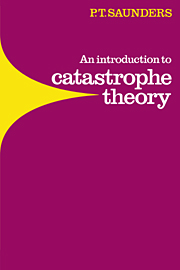Book contents
- Frontmatter
- Contents
- Preface
- 1 Introduction
- 2 Background
- 3 The seven elementary catastrophes
- 4 The geometry of the seven elementary catastrophes
- 5 Applications in physics
- 6 Applications in the social sciences
- 7 Applications in biology
- 8 Morphogenesis
- 9 Conclusions
- Exercises
- Appendix. Elementary catastrophes of codimension ≦ 5
- References
- Author index
- Subject index
4 - The geometry of the seven elementary catastrophes
Published online by Cambridge University Press: 05 June 2012
- Frontmatter
- Contents
- Preface
- 1 Introduction
- 2 Background
- 3 The seven elementary catastrophes
- 4 The geometry of the seven elementary catastrophes
- 5 Applications in physics
- 6 Applications in the social sciences
- 7 Applications in biology
- 8 Morphogenesis
- 9 Conclusions
- Exercises
- Appendix. Elementary catastrophes of codimension ≦ 5
- References
- Author index
- Subject index
Summary
Now that we have the list of seven elementary catastrophes, we have to discover their properties. This is a comparatively straightforward task, and we shall carry out almost all the necessary calculations explicitly.
What we have to do is precisely what we did when we analysed the catastrophe machines in the first chapter. Given a potential, V, we define the equilibrium surface, M, by the equation
where the subscript x indicates that the gradient is with respect to the state variables only. This surface is made up of all the critical points of V, i.e. all the equilibria (stable or otherwise) of the system. We denote it by M to indicate that it is a manifold, a well-behaved smooth surface. It is not, by the way, obvious that M must be a manifold, but it can be proved that it is.
Next we find the singularity set, S, which is the subset of M which consists of all the degenerate critical points of V. These are the points at which ∇xV=0 and also
where H(V) is the Hessian of V, the matrix of second order partial derivatives which we defined in Chapter 2. We then project S down into the control space C (by eliminating the state variables from the equations which define it) to obtain the bifurcation set, B, which is the set of all points in C at which changes in the form of Voccur.
- Type
- Chapter
- Information
- An Introduction to Catastrophe Theory , pp. 41 - 60Publisher: Cambridge University PressPrint publication year: 1980
- 2
- Cited by



